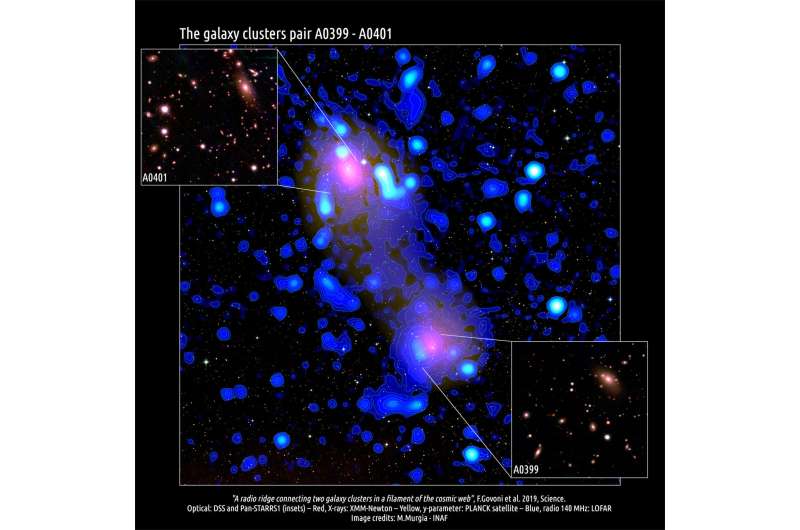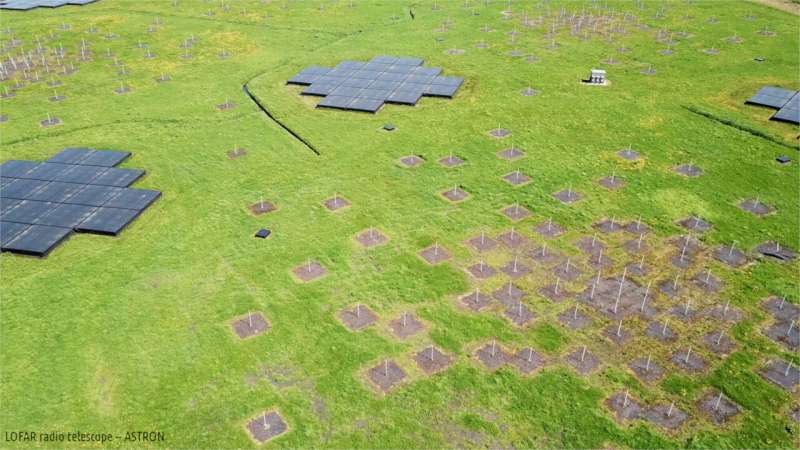Composite image of the galaxy clusters pair Abell 0399 and Abell 0401. The system is at approximately 1 billion light-years from the Earth while the two galaxy clusters are about 10 million light-years apart in projection. The cores of the two galaxy clusters are permeated by a high-temperature plasma that emits in the X-rays (red tones). Furthermore, observations in the microwaves show a tenuous filament of matter connecting the two clusters (yellow tones). The low-frequency image in the radio waves (blue tones) reveals several bright discrete sources associated to individual galaxies and two diffuse radio halos towards the centers of the two clusters of galaxies. A striking ridge of radio emission is visible along the filament connecting Abell 0399 and Abell 0401 revealing the presence of a vast magnetic field illuminated by a population of high-energy electrons. Credit: DSS and Pan-STARRS1 (optical), XMM-Newton (X-rays), PLANCK satellite (yparameter), F. Govoni, M. Murgia, INAF
An international team of researchers has found evidence of a ridge of radio emissions joining two galaxy clusters. In their paper published in the journal Science, the group describes their find and how it fits into cosmological theory.
The work began with results from prior studies reporting that some galaxy clusters have magnetic fields. They chose to focus on two of them, Abell 0399 and Abell 0401, which prior research had shown were in the process of merging. At present, they are still approximately 10 million light years apart. To learn more about the two galaxy clusters, the researchers made use of LoFar, a low-frequency radio telescope that is actually made up of 25,000 antennas spread across 51 locations. Their plan was to learn more about the filaments between the clusters. Filaments are extremely long strands of gases that exist in the empty parts of space—taken together, they make up what is known as the cosmic web.
The researchers report evidence in the filaments of a band of radiation known as a synchrotron emission—a type of illumination that is created by electrons moving through a magnetic field. The researchers report that the magnetic field stretched all the way from one of the galaxy clusters to the other, following a filament between them.
The finding is the first example of a magnetic field extending between galaxy clusters and raises the question of whether it is a common occurrence or if they just happened to stumble onto something rare. It also raises the question of where the electrons came from—computer simulations showed that shock waves generated by the merging action of the two galaxies could not have generated enough emissions to account for observations. The researchers plan to look for more radio bridges, but do not expect such research will get underway until the next generation LoFar goes online—called the Square Kilometer Array, it will represent not only the largest telescope in the world, but a means for taking a much closer look at filaments and possibly other magnetic fields stretching across vast areas of space.
This video presents the stunning environment of Abell 0399 and Abell 0401, a pair of galaxy clusters at approximately 1 billion light-years away. The two galaxy clusters are about 10 million light-years apart in projection, a hundred times the size of our own galaxy the Milky Way. The video starts out exploring the vast space between the two clusters, but this is just the beginning of the story. Observations in the X-rays, in the microwaves, and at low radio frequencies reveal a completely new view of this portion of sky. Credit: DSS and Pan-STARRS1 (optical), XMM-Newton (X-rays), PLANCK satellite (yparameter), F. Govoni, M. Murgia, INAF, Cjbeards, ASTRON
Federica Govoni, researcher at the Italian National Institute for Astrophysics (INAF) talks about the discovery of a radio ridge connecting two galaxy clusters. Credit: Media INAF
The LOw-FRequency ARray, or LOFAR, is the largest radio telescope with connected elements in the world. This aerial view shows one of the many antenna stations composing the array. Credit: ASTRON
More information: F. Govoni et al. A radio ridge connecting two galaxy clusters in a filament of the cosmic web, Science (2019). DOI: 10.1126/science.aat7500
Journal information: Science
© 2019 Science X Network

























